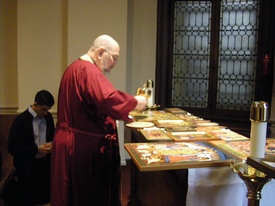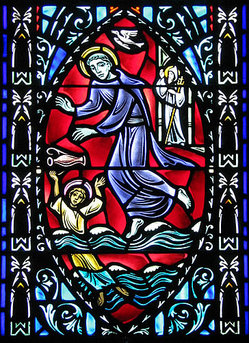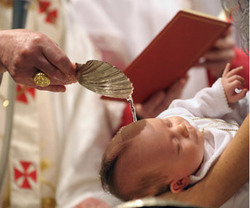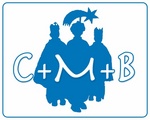Sacred Liturgy & Sacraments: January 2010 Archives
 Last week Father Michael Morris (of the Seminary faculty) blessed an icon for me. This week, another similar service was done by Economos Romanus Russo, an adjunct professor at Saint Joseph's Seminary and pastor of Saint Michael's Russian Byzantine Chapel (266 Mulberry St, NYC).
Last week Father Michael Morris (of the Seminary faculty) blessed an icon for me. This week, another similar service was done by Economos Romanus Russo, an adjunct professor at Saint Joseph's Seminary and pastor of Saint Michael's Russian Byzantine Chapel (266 Mulberry St, NYC).

Today is the feast of the first companions of Saint Benedict of Norcia, Saints Maurus and Placid. The traditional blessing of the sick calling upon Saint Maurus' intercession follows. You may not have a relic of the True Cross or relic of Saint Benedict to you available to you, so the priest should use a crucifix and the Saint Benedict Medal.
Before the blessing is imparted, the relic of the true Cross of our Lord or the medal of Saint Benedict is exposed, at least two candles having been lit. The Act of Contrition and firm confidence should then be excited in the sick person, so that through the merits and intercession of Saint Benedict and Saint Maurus, if it should please God, health may be obtained. Three Our Fathers, Hail Marys and Glory be's are recited in honor of the Blessed Trinity.
Then a priest or deacon, having put on a stole, and with his right hand holding up the relic or the medal of Saint Benedict before the sick person, says the following prayers:
V. Benediction and glory, and wisdom, and thanksgiving, honor and power and strength to our God forever and ever.
R. Amen.
Over the Christmas holiday I acquired an icon of Our Lady of Perpetual Help, written by Brother Terrence McGrath, OCSO, a monk of Saint Joseph's Abbey, Spencer, Massachusetts. In the tradition of the Catholic Church, all icons (religious objects intended for devotion) ought to be properly blessed. The Directory on Popular Piety and the Liturgy teaches us,
The Church blesses sacred images because of their cultic significance. This is especially true of the images of the Saints which are destined for public veneration, when she prays that, guided by a particular Saint, "we may progress in following the footsteps of Christ, so that the perfect man may be formed in us to the full measure of Christ." (244)
Today, Father Michael Morris, a priest of the Archdiocese of New York and history professor of Saint Joseph's Seminary (Dunwoodie-Yonkers, NY) properly blessed the icon.
The Blessing of Icons follows:
Priest: Blessed is our God always, both now and ever, and unto ages of ages:
Server: Amen.
Priest: Holy God, Holy and Mighty, Holy Immortal One, Have mercy upon us.
Priest:
O Lord our God, Who created us after Your own image and likeness; Who redeems us from our former corruption of the ancient curse through Your man-befriending Christ, Who took upon Himself the form of a servant and became man; Who having taken upon Himself our likeness remade Your Saints of the first dispensation, and through Whom also we are refashioned in the image of Your pure blessedness; Your Saints we venerate as being in Your image and likeness, and we adore and glorify You as our Creator; Wherefore we pray You, send forth Your blessing upon this Icon, and with the sprinkling of hallowed water.
Bless and make holy this icon untoYour glory, in honor and remembrance of Your Saint (N) [or, Mother of God]; And grant that this sanctification will be to all who venerate this icon of Saint (N) [or, Mother of God], and send up their prayer unto You standing before it;
Through the grace and bounties and love of Your Only-Begotten Son, with Whom You are blessed together with Your All-Holy, Good and Life-creating Spirit; both now and ever, and unto ages of ages.
Server: Amen.
Sprinkling cross fashion the icon with holy water, he says:
Hallowed and blessed is this icon of St. (N) [or, Mother of God], by the Grace of the Holy Spirit, through the sprinkling of Holy Water: in the Name of the Father (+), and of the Son and of the Holy Spirit: (+), Amen.
Priest: Let us pray to the Lord.
Server: Kyrie eleison.
Priest:
O God our Savior, Who did deign to enter under the roof of Zacchaeus, unto salvation of the same and of all that were in the house; Do you, the same Lord, keep safe also from harm them who now desire to dwell here, And who, together with us unworthy ones, do offer unto You prayer and supplication: Bless this (+) their home and dwelling, and preserve their life free from all adversity; For unto You are due all glory, honor and worship, as also unto Your Eternal Father, and Your All Holy, Good and life-creating Spirit; both now and ever, and unto ages of ages:
Server: Amen.



